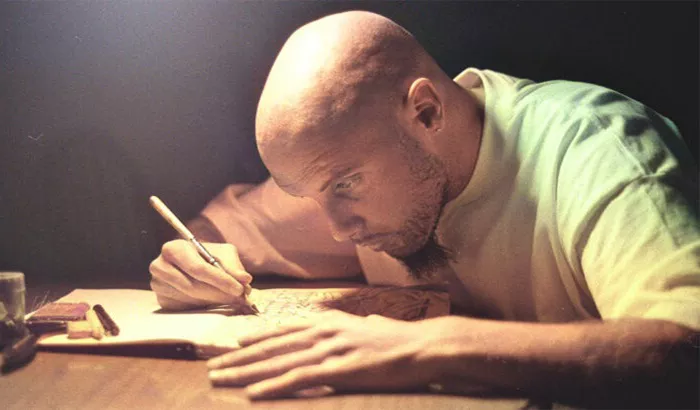A poignant short documentary titled In God’s Hands, premiered at the close of this year, is a tribute to the late Michael Sheerin, a renowned tattoo artist who passed away in 2022 at the age of 42. Directed by his brother, Niall Sheerin, the film explores Michael’s life and artistic journey, particularly his spiritual and creative evolution in the face of illness.
A Life of Art and Resilience
Michael Sheerin, originally from Roscommon, was a tattoo artist who worked internationally, from Dublin to Helsinki, Los Angeles, and beyond. Diagnosed with sarcoidosis in 2020, his health gradually deteriorated, leading to a diagnosis of pulmonary hypertension. Despite his illness, Michael continued to create art that reflected his profound understanding of mortality, faith, and the human spirit.
Speaking to The Irish Catholic, Niall Sheerin described his brother’s creative evolution, noting that as Michael’s health declined, his art became increasingly reflective. “Michael used art to express his inner thoughts and emotions as he was getting sicker,” Niall said. “It became deeper, more profound. And it was interesting looking at that after he died.”
The documentary, Niall explains, is not only a tribute to Michael but also an exploration of his spiritual and artistic journey. “The main goal [of the documentary] is to commemorate Michael. I have a lot of footage from Michael’s phone, from previous documentaries, and his artworks. I decided to create a short film based around those portraits,” he said.
A Drawing of Hope
The title In God’s Hands comes from a powerful drawing Michael made shortly before his death. While in the cafeteria of Galway University Hospital, likely drinking coffee, Michael drew an image that would become emblematic of his faith. In the coffee’s froth, he depicted the face of Jesus, with the words “HOPE” and “FAITH” written on sugar sachets. The cup, held by his own hand, bore the inscription “IN GOD’S HANDS.”
For Niall, this image has become a source of comfort: “He had faith that he was in safe hands, even as he grew increasingly ill, and that brings a lot of comfort to my family,” he reflected. “Nobody realized Michael was dying, but maybe he sensed it himself.”
The Spiritual Dimensions of Michael’s Art
Although Michael was not a conventional churchgoer, his faith was a central influence on both his worldview and his artwork. “Faith gave him immense comfort,” Niall explained. “As he grew older, he became fascinated by religious art—angels, saints, the afterlife. During his illness, he found solace in drawing these images, which reflected his strong belief that he was going somewhere better.”
In the Catholic tradition, suffering is not merely a struggle but a way to participate in Christ’s redemptive work. For Michael, his artwork became a vehicle for processing his pain and finding peace during his illness. His depictions of divine figures—angels, saints, and representations of the afterlife—served as symbols of hope, grace, and God’s presence, even in times of darkness.
Michael’s spiritual journey, while deeply personal, was evident in every aspect of his life, from his art to his conversations. “He started to draw himself as a saint,” said Niall. “He was seeing himself in a different world, which wasn’t apparent when he was alive. It’s only when you look at it now and you think, ‘He was looking at himself from a different point of view.’ That might have been him coming to terms with his illness and his own mortality.”
Michael’s fascination with religious imagery grew stronger as his health declined, reflecting a deeper spiritual awakening. “He was obsessed with drawing angels and saints,” his brother recalled. “He was always very interested in Renaissance art, which is full of themes about the afterlife and angels. It’s interesting that when he got sick, his work became focused on that.”
A Legacy of Inspiration
As we move into the New Year, Michael’s story serves as a reminder of the importance of faith, creativity, and gratitude. His philosophy on life was simple yet profound: “Life is yours to live,” he often said. “He taught me to be positive and to believe in something.”
Niall Sheerin, through his documentary, has ensured that Michael’s legacy endures. “Michael’s art is still alive in the world. On walls, on skin, and in people’s lives. That’s the blessing of it all,” he said. “His work carries his essence forward, giving comfort not just to our family, but to everyone touched by his creativity.”
Despite his passing, Michael’s presence is still felt. Niall reflects, “Since his passing, I’ve felt his presence. In a strange way, he’s never left. It’s as though he knew he’d die, and he drew himself as a saint, as if he knew his place in our lives after he was gone.”
Art as a Window to the Infinite
Michael’s later works, which feature angels, saints, and the afterlife, echo a sentiment expressed by Pope Pius XII in 1952. In an address to Italian artists, the Pope said, “The function of all art lies in breaking through the narrow and tortuous enclosure of the finite, in which man is immersed while living here below, and in providing a window to the infinite for his hungry soul.”
Michael Sheerin’s work, particularly his spiritual themes, reflects this idea. His art continues to offer a window into the infinite, transcending his earthly struggles and leaving behind a legacy that touches those who encounter it.
In the film, Niall Sheerin has not only paid tribute to his brother’s artistry but also to the transformative power of faith and creativity. As Michael’s story and art continue to inspire, his legacy reminds us that even in the face of illness and mortality, there is always hope, beauty, and the possibility of finding peace.
Related topics:

